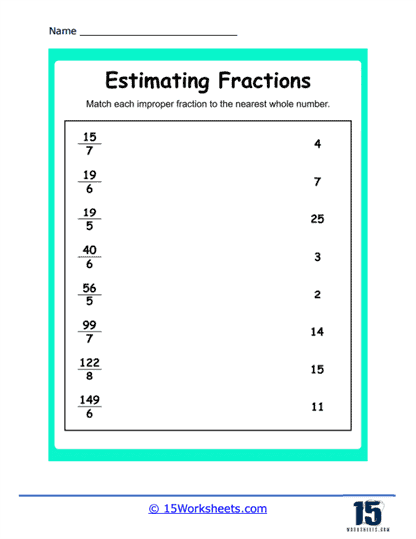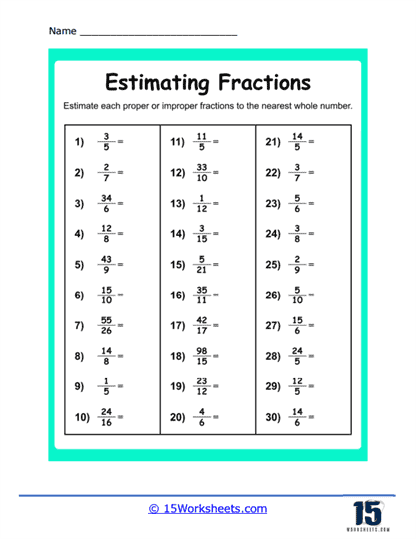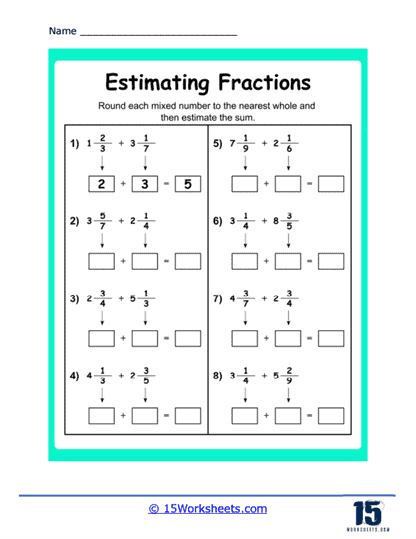Estimating Fractions Worksheets
About These 15 Worksheets
Estimating fractions is an important mathematical concept that can make complex calculations simpler and help in making quick decisions. A fraction represents a part of a whole. For example, if you have a pizza divided into 8 slices and you’ve eaten 3, you’ve eaten 3/8 of the pizza.
But what if you have 5/8 of a pizza and want to add 3/4 of another pizza? Adding these two fractions directly might seem complicated, especially if you’re trying to calculate in your head. That’s where estimation comes in. Instead of finding the exact answer, you’d find a close approximation, which is usually good enough for practical purposes.
Let’s break down the types of problems you might encounter when working with these worksheets:
Estimating Sums and Differences – These problems require you to estimate the result (sum or difference) of adding or subtracting fractions. For example, if you have to estimate the sum of 5/8 and 3/4, you might round 5/8 to 1 and 3/4 to 1, then add them to get an estimated sum of 2.
Estimating Products – Here, you’ll need to estimate the result (product) of multiplying fractions. If you need to estimate the product of 7/8 and 2/3, you might round 7/8 to 1 and 2/3 to 1, then multiply them to get an estimated product of 1.
Estimating Quotients – These exercises involve estimating the result (quotient) of dividing fractions. For instance, to estimate the quotient of 9/10 divided by 4/5, you might round 9/10 to 1 and 4/5 to 1, then divide to get an estimated quotient of 1.
Mixed Numbers – Sometimes, you might need to estimate the sum, difference, product, or quotient of mixed numbers (numbers that include both a whole number and a fraction, like 2 1/2).
Using a Number Line – Students may be given a fraction and asked to estimate its position on a number line. This helps develop their understanding of fractions and their relative magnitudes.
Equivalents – Students may be asked to estimate equivalent fractions for a given fraction. They would need to find fractions that are close in value to the original fraction while having simpler or more familiar denominators.
By practicing with these worksheets, you’ll get better at making these approximations quickly and accurately, which is a valuable skill not only for your math classes but also for daily life. Let’s look at some examples of when you might use this skill:
Cooking and Baking – Recipes often involve fractions. If you’re doubling a recipe, you might need to add fractions together. Or if you’re dividing a recipe in half, you might need to divide fractions.
Woodworking or Crafting – If you’re building or making something, you might need to measure lengths that aren’t whole numbers, which often involves fractions.
Sports – If you’re keeping track of statistics in a game, like a batting average in baseball or a shooting percentage in basketball, you’ll be working with fractions.
Shopping – If you’re comparing prices and discounts, or trying to figure out what’s the better deal, you might need to work with fractions.
Estimating fractions worksheets aim to develop students’ fraction sense, critical thinking, and approximation skills. By practicing estimating fractions, students learn to make informed and reasonable estimates of fraction values, which can be useful in everyday situations and problem-solving tasks involving fractions.















